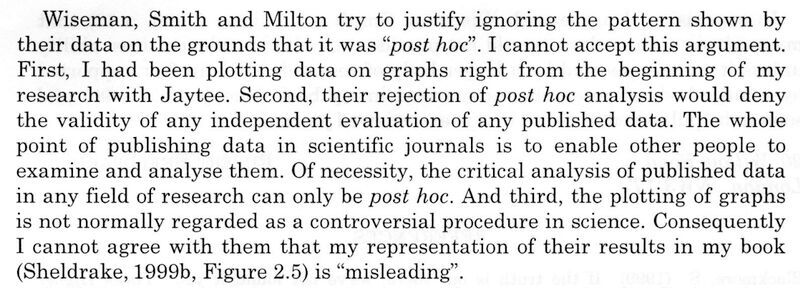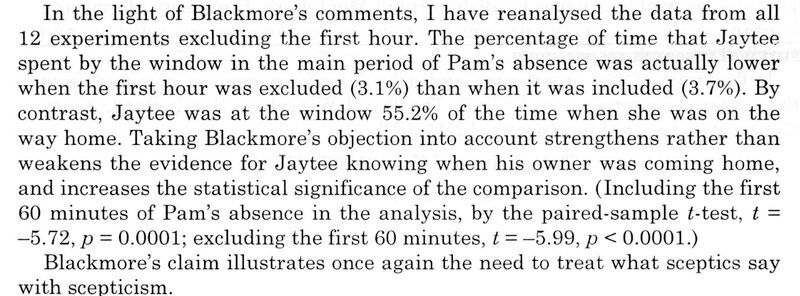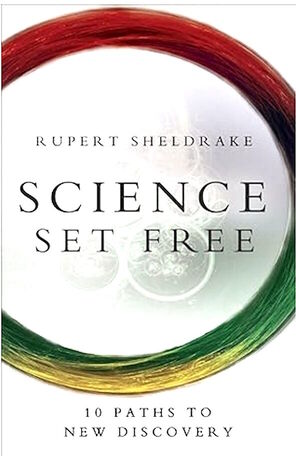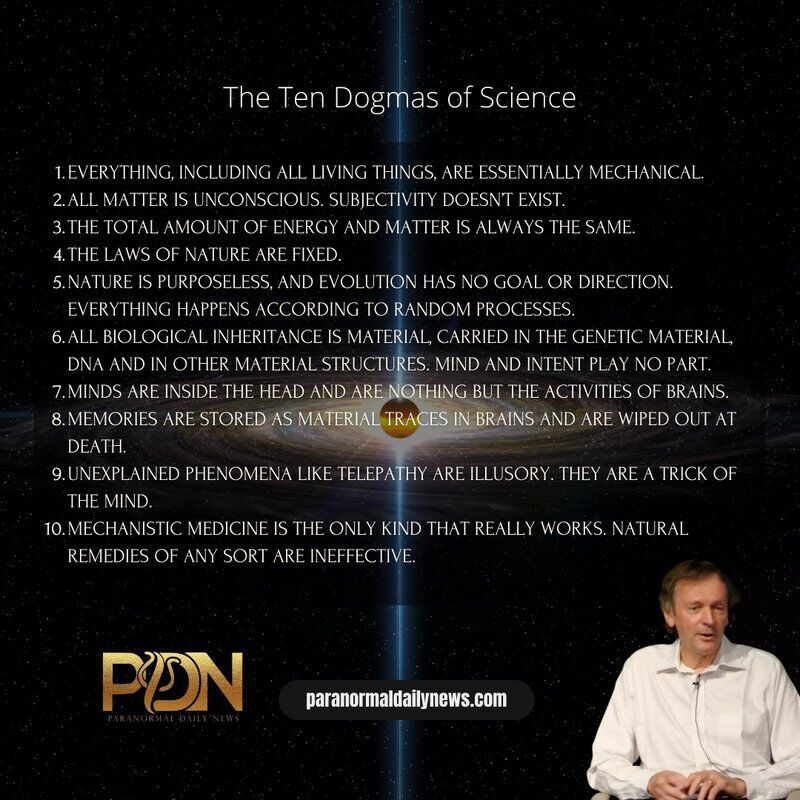Prior to that time, Rupert had a decent Wikipedia page, but as his notoriety grew, his page became the playground of his enemies, making him look worse and worse as they edited out his accomplishments and plastered the word "pseudoscience" everywhere. It's got the fingerprints of the Guerrilla Skeptics on Wikipedia all over it. They are an anti-intellectual atheist materialist Wikipedia editing group dedicated to teaching the world that we have brains, but no minds. But first, a little backstory.
At the time, Rupert was talking about his then new book Science Set Free, where he talked about the ten dogmas of science, which are worth repeating here because it clarifies what ideologies are at play:
The Ten Dogmas of Science
- Everything, including all living things, are essentially mechanical.
- All matter is unconscious. Subjectivity doesn't exist.
- The total amount of energy and matter is always the same.
- The laws of nature are fixed.
- Nature is purposeless, and evolution has no goal or direction. Everything happens according to random processes.
- All biological inheritance is material, carried in the genetic material, DNA and in other material structures. Mind and intent play no part.
- Minds are inside the head and are nothing but the activities of brains.
- Memories are stored as material traces in brains and are wiped out at death.
- Unexplained phenomena like telepathy are illusory. They are a trick of the mind.
- Mechanistic medicine is the only kind that really works. Natural remedies of any sort are ineffective.
The enemies of Sheldrake who control his biography absolutely believe these dogmas as though they were etched in stone. This is what Sheldrake was challenging in his book. He argued that we should question these beliefs and that there were other ways to conceptualize the universe.
Sheldrake is at home with ideas like collective consciousness and telepathy and his most well known theory, morphic resonance, relies on these concepts. Morphic Resonance describes how entire species have a collective mind that they draw upon to spread information. This, of course, runs entirely counter to the beliefs of these zealot editors.
Rupert's Popularity
As far as Wikipedia goes, what's interesting about Sheldrake is that he is a popular figure with a lot of very science-literate followers. So naturally, when people see the abysmal state of his biography, they step up to see if they can help. This has been going on for years. You can see it in the talk page right at the top:

Failures Of Skeptics
That banner, in other words, is an advertisement for the Guerrilla Skeptic's utter failure to be able to intellectually defend their position. Instead, they've resorted to a line of reasoning that would be more at home in a Monty Python sketch.
I'm going to use one of Rupert's favorite methods of cutting through the noise: phrase this as a question. Is he fringe? Is it pseudoscience? If the answer to both is no, then all the other objections to a neutral biography are moot.
The Wikipedia Fringe Label
Is Rupert Sheldrake fringe? By the Wikipedia definition, fringe is defined as: an idea that departs significantly from the prevailing views or mainstream views in its particular field. Is Morphic Resonance fringe by this definition? The answer is no if you stay within the context of how scientific inquiry and exploration normally works. Fringe within the context of science means that the concept won't pass ordinary peer review within its own field, much less get into more generalized journals like Nature. Fringe, as it applies to science, is usually one person pushing an idea that no one else takes seriously.
Morphic resonance passes the basic test of science in that it is falsifiable. You can run experiments that test the theory, which has been done. There are also references to it from other scientists as early as 1938, (Spemann), (Weiss, 1939).
Morphic Resonance is taken seriously by other scientists and references to it can be found in various journals and some experimental evidence supports it, particularly within its field. This is science that is going through the ordinary process of discovery at the usual snail's pace. Adoption hinges on some rethinking of the fundamental assumptions that Sheldrake addressed in his TED talk. And scientific testing of Morphic Resonance is part of what is creating the need for this rethinking.
The whole discussion of the nature of the universe is a huge scientific controversy that has been growing. There are consciousness researchers currently making submissions for a $100,000 prize. There are a number of people closing in on theories of consciousness in physics, which has gained momentum due to the 2022 Nobel Prizes in physics.
The Nobel Prize in Physics 2022 was awarded jointly to Alain Aspect, John F. Clauser and Anton Zeilinger "for experiments with entangled photons, establishing the violation of Bell inequalities and pioneering quantum information science."Information is a form of consciousness, so this prize is essentially saying that there is consciousness in physics, which in turn makes Morphic Resonance quite plausible. The objection that the theory somehow defies physics is removed here. It isn't enough to rely on second sources for this topic because there are legitimately competing views. Labeling the theory (and the man) as fringe is a way of taking sides in a debate that Wikipedia editors are woefully unqualified to tackle.
The Wikipedia Pseudoscience Label
Then we move on to the designation of "pseudoscience." The Wikipedia definition is:
Pseudoscience is often characterized by contradictory, exaggerated or unfalsifiable claims; reliance on confirmation bias rather than rigorous attempts at refutation; lack of openness to evaluation by other experts; absence of systematic practices when developing hypotheses; and continued adherence long after the pseudoscientific hypotheses have been experimentally discredited.[4]Let's go through this list for Morphic Resonance:
- Contradictory? No
- Exaggerated? No
- falsifiable? Yes
- Reliance on confirmation bias rather than rigorous attempts at refutation? No
- Lack of openness to evaluation by other experts? No
- Absence of systematic practices? No
- Continued adherence after experimentally discredited? N/A
Why You Can't Rely on Sourcing on Wikipedia
This manipulation is most visible in the sourcing: This is important because journalists often skip the article, but then rely on sourcing. That doesn't work either. The following sources cited in this article are associated in some way with the Center for Inquiry/Committee for Skeptical Inquiry (CSI)/the Skeptical Inquirer/Prometheus Books:
- 5. A book containing articles by fellows of CSI: David Gorski, Chris French
- 6. Skeptical Inquirer
- 8. One of the writers is a CSI fellow: Massimo Pigliucci
- 11. Skeptical Inquirer
- 14. Prometheus Books
- 17. Founder of CSI: Martin Gardner
- 23. CSI Fellow: Jerry Coyne
- 24. CSI Fellow: Susan Blackmore
- 26. Not a CSI Fellow, but aligned with them. Pub. of Skeptic Magazine: Michael Shermer
- 32. See 26. Shermer
- 33. See 26. Shermer
- 60. See 26. Shermer
- 65 CSI Fellow: Robert Todd Carroll
- 66. CSI Fellow: Susan Blackmore
- 68. CSI Fellow: James Alcock
- 69. CSI Fellow: Richard Wiseman
- 82. CSI Fellow: Susan Blackmore
- 84. CSI FEllow: Richard Wiseman
- 90. Skeptical Inquirer
- 91. Skeptical Inquirer
- 92. Skeptical Inquirer
- 93. See 26. Shermer
- 97. CSI Fellow: Massimo Pigliucci
In case you were wondering, four of these people have a legitimate reason to be cited in some specific situations: Richard Wiseman replicated one of Sheldrake's experiments where they did testing on whether dogs know that their owner is coming home. Susan Blackmore wrote a couple of specific critiques on specific experiments, and Steven Rose critiqued Morphic Resonance.
They were involved in scientific discussions that are part of the process. Rose's critique can be found in full on Rupert Sheldrake's website, but in an act of pettiness, the Guerrilla Skeptics have chosen to cite the Wayback machine, lest anyone be exposed to the horrors of woo. The interaction with Shermer was an unnecessary addition to the biography.
This isn't a biography, it's an advertisement for these skeptics, all of whom have well done, complimentary Wikipedia biographies. It's an example of reward your friends, punish your enemies.
Misrepresentation of Research by omitting Rebuttals
I suppose I should mention that the article makes a hash of Rupert Sheldrake's work by over emphasizing criticism and leaving out rebuttals and positive attributes. For example, in the section on dogs that know when their owner is coming home, Richard Wiseman replicated the experiment and got the same results as Sheldrake. Rather than admit this, he simply moved the goal posts, adding criteria that were not in the original experiment and then declared the experiment a failure.


It's not just Rupert Sheldrake; it's not just Parapsychology; it's a whole weird list of things that these atheists object to. They are on a crusade against chiropractors and Santa Claus as well. As stated earlier, they claim that we are just brains and chemical processes and that consciousness is just a brain process and doesn't actually exist. They truly don't believe that we have minds.
One cannot help but wonder if this belief in mindlessness isn't just a bit of self reflection.







Reader Comments
Incidentally, whilst attending University, I would arrive home at irregular hours, no two days the same. My mother insists she could always predict my arrival as, twenty minutes prior, my cat (a Seal-point Siamese) would take up a position on the front porch. The University was a twenty minute drive from home.
The insistence of modern Scientism on purely material and observable phenomena is ludicrously revealed in their invention of "dark" matter and energy. They know something is wrong with their equations, and the solution is claimed to be "unobservable" magic... and they cannot see the inadvertent hypocrisy.
It seems rather tragic, but I find in instead to be laughable.
Rock on, Rupert.
The implication is that one must be open to theism to grasp morphic resonance, yet morphic resonance does not rely on the acceptance of any particular theistic notion for its tenets.
The author belies his own biases with the ad hominem attacks rather than rely on the merits of the arguments.
I think most of us are aware that Wikipedia is not an objective encyclopedic view of anything. It is a site for the manipulation of information and people, just like "fact checkers".
The question to ask, why is Sheldrake attacked as pseudo-science? Why are his theories dangerous to the "scientism" of our time?
Just read the list of dogma's of science. Then ask one question: Can consciousness exist outside of a physical body? According to scientific materialism, no.
This is not more scientific than dogs magically knowing when their owners are arriving, just more accepted by the 'right' people.
Th'-Theeuh-Th'-That's All, Folks!
then they denigrate and insult you
Finally they accept your theory.'
Part of the Rubik’s cube rebus is to uncover the mysteries of how things are interconnected or work.
Ruling hierarchy creates Convention for control.
Been following Rupert since the Trialogues with him, Abram’s & McKenna. I suspected they were all connected to Esalen Institute, Stanford Research Groups and the Mothership Tavistock Institute of Human Relations & all things MI6/CIA.
I suspect part of Quantum Mechanics - Quantum Entanglement are all connected to Sheldrake’s Morphic Resonance theory. Taping into the Quantum Field is probably something that will be revealed with greater clarity in my lifetime but it was already long discovered by Max Planck/Von Heisling et alia.
Rock on Rupert 🌞🦋🍄🔥🦅